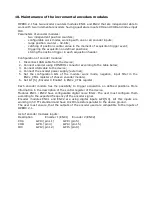
a) the acquisition in progress
In this case the new acquisition will be not started, and trigger impulse will be counted by
the module of lost triggers counter (TrgOverrun) and the bit TrgOvrScr_A in CAPT_REG
will be set. The value of this counter is written to the acquisition header immediately after
it is finished. This value shows the amount of triggers that was lost since the previous
acquisition was finished – during the actual acquisition.
b) the frequency of trigger pulses is larger than 10kHz (their period is smaller than 100µs)
OPBOX-2.1 has internal module limiting maximal repetition speed to 10kHz (trigger
period 100µs). Trigger pulses coming quicker than 100µs since previous trigger are
ignored and their amount is counted by TrgOverrun module and bit TrgOvrScr_H in
CAPT_REG is set);
c) the memory of internal buffer is full:
If the buffer has no place to store the next acquisition frame, all trigger pulses are
counted by the TrgOverrun counter and the TrgOvrScr_F in register CAPT_REG is set).
This register are written to the header after the next acquisition is made (after freeing
the place in the buffer);
d) the power supply control system has informed about the power supply failure
OPBOX-2.1 has a power control system fulfilling the needs of USB-2.0 interface
specification and to secure the system for the case of overload of power supply.
POWER_CTRL register contains the description of status flags of the power supply
module. If on trigger event any of this flags shows error, the acquisition is not made and
the pulse is counted by the TrgOverrun counter and the bit TrgOvrScr_P in CAPT_REG is
set). It prevents acquisitions with potentially erroneous or unstable settings (for
example voltage level).
After receiving the frame, it is possible to check in the header the amount of lost triggers
since the start of previous acquisition and the reason for this event (CAPT_REG register).
Each of flag TrgOvrScr_A, TrgOvrScr_H, TrgOvrScr_F and TrgOvrScr_P in CAPT_REG
register informs about the fact, if at least one trigger event took place, that was missed for
some concrete reason. This flags can be helpful in quick diagnosis of problems with the
device, measurement speed, etc. It is possible to set more than one flag. Reasons for
loosing trigger events could overlap, for example in the case, if the next trigger event
occurrs during on going acquisition and earlier than 100µs after its beginning both flags
TrgOvrScr_A and TrgOvrScr_H will be set.
8.5. Resetting of Acquisition buffer
Acquisition buffer of the device can be reset at each moment with the help of the
DIRECT_RESET_FIFO
(0xD2) command. This command causes that all acquisitions will be
removed from the buffer.
Resetting acquisition buffer do not reset the acquisition
settings!
Such parameters as PACKET_LENGTH, DEPTH remaining unchanged. Resetting all
settings is possible with the global reset command: DIRECT_RESET (0xD1)). Global reset
resets acquisition buffer too.
8.6. Time gain compensation curve (TGC)
Configuring the device to work with the generation of arbitrary TGC curve during acquisition
in FIFO mode requires appropriate preparation of the table of TGC curves with the size, that
is equal the size of the buffer for this curves (TGC memory). The size of this buffer is equal
the size of the acquisition buffer (256kB)
The table of TGC curves must include PACKET_LEN_MAX amount of copies of a single
amplification curve with the length DEPTH bytes, that must be placed in the whole table
with the distance of FRAME_SIZE bytes and shifted by HEADER_SIZE=54 bytes in the
relation to the begin of each frame. First 54 bytes should be written with the first value of
amplification from the TGC curve.
The detailed structure of the TGC curves table is shown on the following diagram:



































